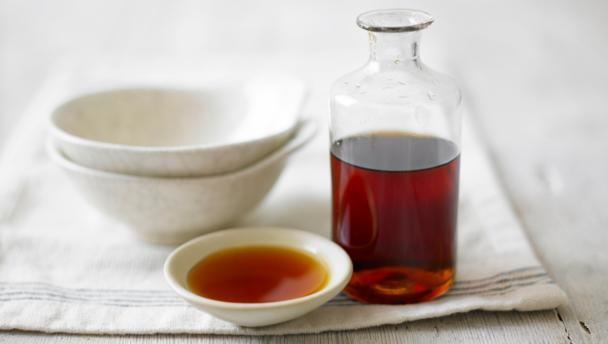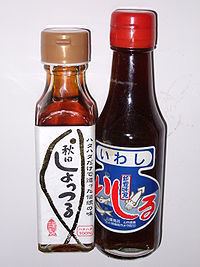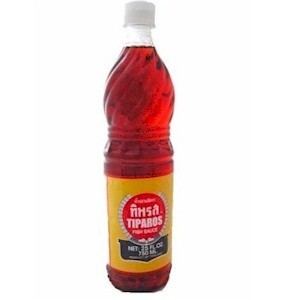 | ||
Similar Water, Sugar, Oyster sauce, Chili pepper, Soy sauce | ||
3 shocking ways to use fish sauce explore flavour
Fish sauce is an amber-colored liquid extracted from the fermentation of fish with sea salt. It is used as a condiment in various cuisines. Fish sauce is a staple ingredient in numerous cultures in Southeast Asia and the coastal regions of East Asia, and features heavily in Burmese, Cambodian, Filipino, Thai, Lao and Vietnamese cuisines. It also was a major ingredient in ancient European cuisine, but is no longer commonly used in those regions.
Contents
- 3 shocking ways to use fish sauce explore flavour
- Types
- Southeast Asian
- Japanese
- Korean
- Western
- References

In addition to being added to dishes during the cooking process, fish sauce is also used as a base for a dipping condiment, prepared in many different ways in each country, for fish, shrimp, pork, and chicken. In parts of southern China, it is used as an ingredient for soups and casseroles. Fish sauce, and its derivatives, impart an umami flavor to food due to their glutamate content.
Types

Most fish sauces (extracts) are made from raw fish, some from dried fish; some come from only a single species, others from whatever is dredged up in the net, including some shellfish; most from whole fish, a few from only the blood or viscera. Most fish sauces contain only fish and salt, others add a variety of herbs and spices. Fish sauce that has been only briefly fermented has a pronounced fishy taste, while extended fermentation reduces this and gives the product a nuttier, richer and more savory flavor. An anonymous article, "Neuc-num", in Diderot and d'Alembert's 18th-century encyclopedia, states: "It is said that Europeans become accustomed enough to this type of sauce".
It is thought that a Chinese fish sauce from its southern coastal region, called kôechiap in the Min Nan Chinese language, might be the precursor of the tomato sauce called ketchup. Sauces made from fermented fish parts with other ingredients such as meat and soya bean added to it, have been recorded in China 2300 years ago.
Southeast Asian
Southeast Asian fish sauce is often made from anchovies, salt and water, and is usually used in moderation because it is intensely flavoured. Anchovies and salt are arranged in wooden barrels to ferment and are slowly pressed, yielding the salty, fishy liquid. The salt extracts the liquid via osmosis.

The variety from Vietnam is called nước mắm. Two areas in Vietnam are most famous for producing fish sauce: Phú Quốc and Phan Thiết. Popular brands include Red Boat, 3 Crabs, Golden Boy, and Hon Phan Thiết. The quality of fish sauce is determined by many factors. Some Vietnamese fish sauces are made with only two ingredients: anchovies and salt. They do not have any additives like sugar, hydrolyzed protein, or preservatives. Another factor is the sauce should not have a particularly strong smell, and it should be transparent with a deep golden amber color. “First press” fish sauce, meaning the sauce is bottled from the first time the fermenting barrels are drained, also indicates quality. Lastly, when measuring the nitrogen level of fish sauces (N), most fish sauce on the market falls within the mid 20N range. Anything over 30N is considered high-grade, and 40N is optimal.
Nước chấm is a Vietnamese prepared fish sauce condiment dipping sauce that is savory, lightly sweet and salty tasting, and can even be sour and spicy if lime and chili peppers are added. The main components are fish sauce, water, and sugar. In Vietnam, there is a popular food item called mắm, which is made the same way as fish sauce, except that both the fish and the liquid extract, not just the liquid, are kept, and mắm is fermented for a shorter period than fish sauce. Mắm is either eaten as is (uncooked), or cooked in soups or stir-fries. Similar condiments from Thailand and Burma are called nam pla (น้ำปลา) and ngan bya yay (ငံပြာရည်) respectively. In Lao/Isan it is called nam pa, but a chunkier, more aromatic version known as padaek is also used. Similar to padaek is pla ra used in Thai cuisine. In Cambodia, it is known as teuk trei (ទឹកត្រី), of which there are a variety of sauces using fish sauce as a base.
The Indonesian semi-solid fish paste terasi, the Cambodian prahok and the Malay fermented krill brick belacan or budu from liquid anchovies are other popular variations of the same theme.
The similar Philippine version common to Indochina is called patis. Patis, a by-product of bagoong, is nearly always cooked prior to consumption, even when used as an accent to salads or other raw dishes. Patis is also used as an ingredient in cooked dishes, including a rice porridge called arroz caldo and as a condiment for fried fish. Patis is also used in place of table salt in meals to enhance the flavor of the food, where it can either be dashed from a dispensing bottle onto the food, or poured into a saucer and mixed with calamansi and used as a dipping sauce.
Southeast Asians generally use fish sauce as a cooking sauce. However, there is a sweet and sour version of this sauce which is used more commonly as a dipping sauce (see nước chấm). In Thai cuisine, fish sauce is used both in cooking and also served at the table for use as a condiment, for instance in noodle soups. In addition, nearly every Thai meal is served with phrik nam pla as a condiment: a mixture of fish sauce, lime juice, and chopped bird's eye chilies. Very often a few slices of garlic are also added to this sauce.
It is mainly the ethnic Chinese (usually Hokkien and Teochew) who cook with fish sauce (鱼露 yúlù, 虾油 xiāyóu in Hokkien) in Indonesia and Malaysia. Fish sauce is a staple of many dishes in cuisines such as Cambodian, Laotian, Philippine, Thai, and Vietnamese.
Japanese
In Japan, it is used as a seasoning of local specialties. Ishiru in the Noto Peninsula is made from sardine and squid. Shottsuru of Akita Prefecture is chiefly made from sailfin sandfish. Ikanago shoyu of Kagawa Prefecture is made from sand lance. They are often reserved for the preparation of nabemono.
Korean
In Korea, fish sauce is called eojang(Korean: 어장).
Across Korean Peninsula, aekjeot(Korean: 액젓, literally "liquid jeotgal"), a type of eojang usually made of fermented myeolchi(anchovy) or kkanari(sand lance), is used as a crucial ingredient in many types of kimchi, both for taste and fermentation.
In Jeju island, eoganjang(Korean: 어간장) made of fermented godori(young chub mackerel) or jeongaengi(horse mackerel) is used as a soy sauce substitute.
Western
Fish sauces were very widely used in ancient western cuisine.
The earliest known reports of fish sauce are from ancient Greece between 4-3rd century BC. It was made with a lower salt content than modern fish sauces.
A salty fermented fish sauce was ubiquitous in Classical Roman cooking, where in Latin it is known as garum or liquamen, and also existed in many varieties such as oenogarum (mixed with wine), oxygarum (mixed with vinegar) and meligarum (mixed with honey). It was one of the trade specialties in Hispania Baetica. It was made of a variety of fish including tuna, mackerel, moray eel, and anchovies. Garum was frequently maligned as smelling bad or rotten, being called, for example, "evil-smelling fish sauce." "Garum" is said to be similar to modern colatura d'alici, a fish sauce used in Neapolitan cuisine.
In English it was formerly translated as fishpickle. The original Worcestershire sauce is a related product because it is fermented and contains anchovies.
